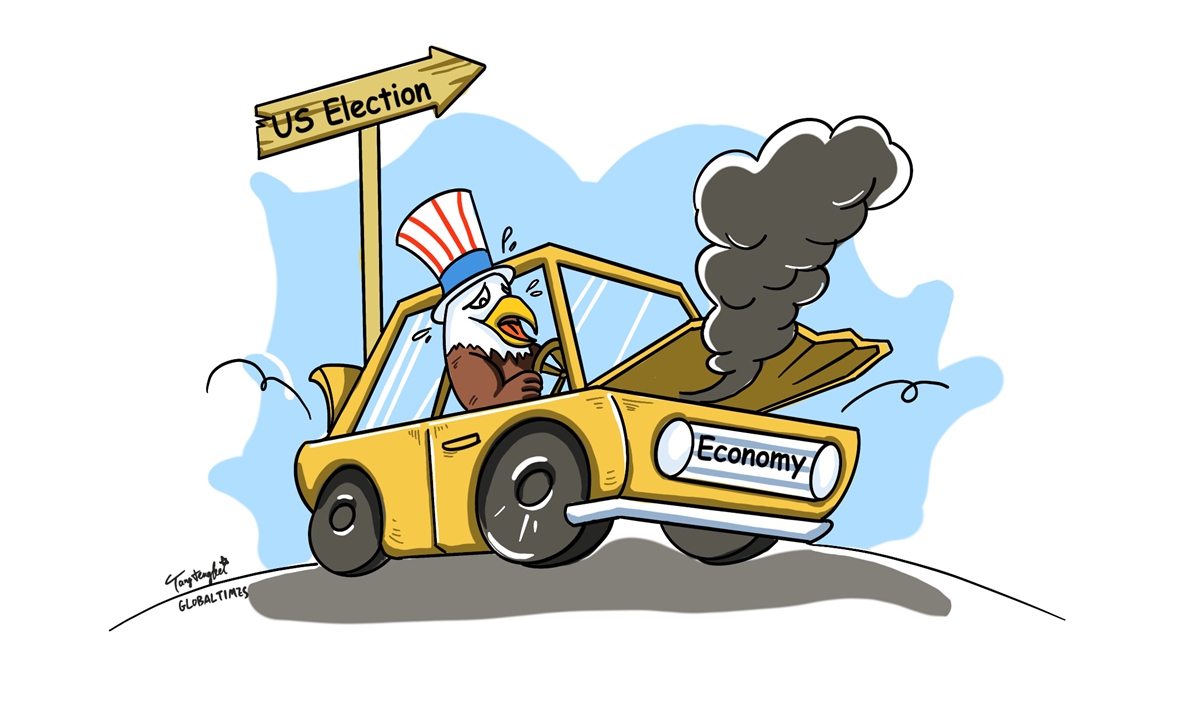US unlikely to see V-shaped recovery before election
By Song Guoyou Source: Global Times Published: 2020/7/27 19:53:40

Illustration: Tang Tengfei/GT
With the highest number of confirmed COVID-19 infections in the world, the US is unlikely to see the V-shaped economic revival which the Trump administration is eager to achieve, as the 100-day countdown to the November 3 presidential election draws near.Even before the onset of the pandemic, the US economy had witnessed weakened growth at 2.3 percent in 2019. The spread of the novel coronavirus pandemic has made economic reopening more difficult, with an IMF forecast in June predicting the US' yearly GDP could contract by 8 percent in 2020.
After months of poorly handling virus prevention, the US hasn't found an effective way to restrict the infections. Per data from the Johns Hopkins University, the country has reported over 4.2 million COVID-19 cases as of Monday, nearly twice the number in Brazil - the country with second-highest number of infections.
As the risk of even high infections remains during the second half of the year, a V-shaped economic recovery before the November presidential election will be anything but an easy task for the White House.
Under grim economic prospects, the unemployment issue is one of the biggest challenges for the US authorities. The nation previously rolled out a $2.2 trillion stimulus package that included $600-per-week check for each jobless. Over 40 million Americans have reportedly applied for the bailout. The measure has expired over the weekend.
And a new government stimulus deal may not be concluded quickly, reported the Washington Post, citing Senate Majority Leader Mitch McConnell. Though the US' unemployment aid packages could relieve unemployment pressure amid the pandemic, they will not fundamentally solve the jobless problem, unless the US economy recovers promptly.
The US Federal Reserve has few tools remaining in its kit after pledging unlimited quantitative easing in March.
The US' financial market, however, has shown an increasing trend toward "decoupling from the gloomy real economy." Though a relatively stable financial market could be a good sign for the country's economy, an inconsistent pace reveals that the critical problem is how to lead a growing financial market to facilitate the real economy, as a stable financial market does not necessarily bring about effective economic recovery.
As the world's largest economy relies heavily on its services sector, the stable and effective resumption of its services industries would offer the largest driving force for the nation's economic recovery. And that leads back to the US' inefficiency in containing the coronavirus.
Instead of focusing on coronavirus prevention and control, however, the Trump administration has been ramping up its efforts to confront China. Trump recently said that the China-US phase one trade deal means much less to him than before, attempting to deflect the blame for the US' virus outbreak and fuel anti-China sentiment in order to help his reelection bid. But despite his constant overstatements, the phase one trade deal could directly influence his voters, especially American farmers. The phase one deal still plays a role in backing up China-US relations.
The author is deputy director of Center for American Studies, Fudan University. bizopinion@globaltimes.com.cn
Posted in: EXPERT ASSESSMENT